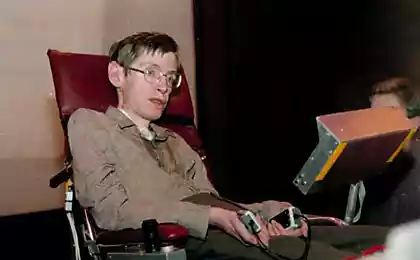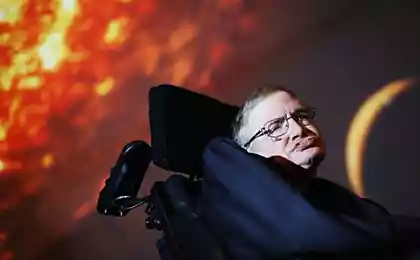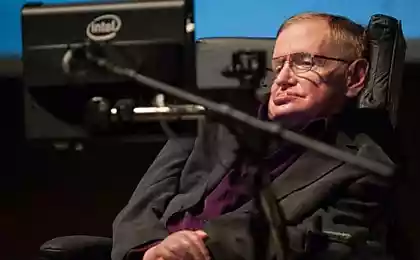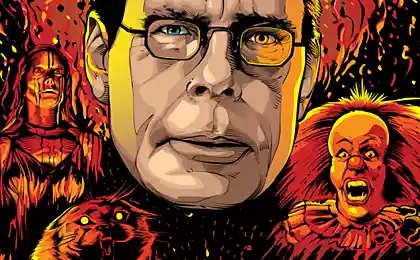905
Stephen Hawking: "In God there was no need, and God did not have time"
Editorial fascinating physics! We publish the article as one of the most famous theoretical physicists of our time, Stephen Hawking, sought God and found ... 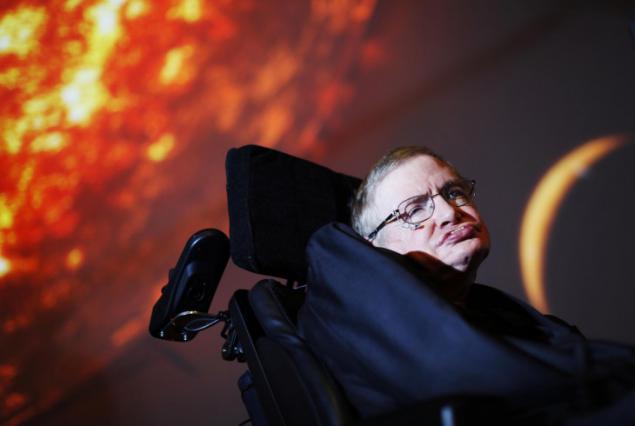
«For centuries it was thought that people like me, that is, people with disabilities, cursed by God. I think I'm somebody now! Destroy, but I personally believe that it is possible to explain everything in a different way - namely, the laws of nature "- a word the most famous scientist of our time, the British astrophysicist Stephen Hawking. They reveal the essence of the relationship with the Supreme Hawking.
No need to be a psychologist to understand Hawking lifetime struggling with God for the fact that he did so "punished." But perhaps it was the opposite - the creator of "punishing" the scientist, because, while still a young man, before his illness, he decided to grasp its secret? The irony of this paradox can only be compared with the irony of the universe, closed itself to itself, which is finite in extent, but it has no boundaries. Such antinomies exist at the boundary of physics and philosophy. But in terms of the laws of nature - is there a creator? We will tell you what he thinks about Stephen Hawking.
Science and religiyaEti opposites are fighting each other for about three thousand years. In 1277 Pope John XXI was so scared that there are laws of nature that announced their heresy. But, alas, he was not able to forbid even one of them - gravity. A few months later the roof collapsed palace directly on the pope's head.
However, the religion with its plastic logic immediately found a solution to all problems. She quickly announced laws of nature, the handiwork of God, which will change these laws at any time, as soon as the "want." And a fire - who conceive another.
Later it turned out that all a bit more complicated. The humble church was ready for it. In 1985, at a conference on cosmology in the Vatican, Pope John Paul II said that there is nothing reprehensible in the study of the universe. "But we - said the pope - no need to wonder about its origins, since it was the handiwork of the Creator." But Stephen Hawking is still wondered.
To answer this question, according to Hawking, you must understand the nature of all three ingredients that make up the "meal of the Universe": matter, energy and space. But where did they come to this "kitchen"? The answer is given by Einstein. But he "stood on the shoulders of giants", so first things first.
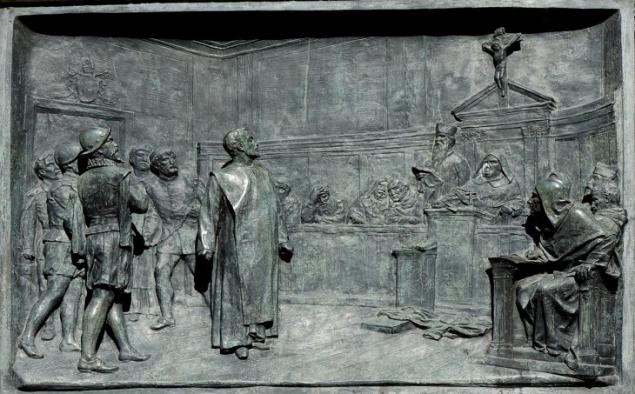
Aristotle, Newton and GalileyV basis of his laws of motion, Newton is known to put Galileo's measurements. Recall that in the last experiments with the body rolled down an inclined plane under the influence of a constant force, gave him constant acceleration. Thus, it was shown that the actual effect of the force - speed variation of the body, rather than bringing it in motion, as it was considered before. Another implied that the body is not exposed to any force, it moves in a straight line at a constant velocity (Newton's first law).
In addition to the laws of motion, Newton's work and describe the determination of the specific type of forces - gravity. According to the law of gravity, any two bodies attract each other with a force directly proportional to the product of their masses.
The main difference between the views of Aristotle on the one hand and the ideas of Galileo and Newton, the other is that Aristotle believed peace natural state of any body to which it is committed, if the action does not feel any force. Aristotle, for example, believed that the earth is in a state of rest. But Newton's laws should be: there is no rest. Everything is in motion. And the earth and the train riding on it.
What is this? The lack of an absolute "standard of rest" for physics was the same effects that pupils Parish School - university entrance. It followed that it is impossible to determine whether there will be two events occurring at different times in the same place. And it already means nothing, as the absence of an absolute, fixed space. Newton is strongly discouraged because it is not consistent with the idea of an absolute God. In the end, it actually refused the conclusion that it was a consequence of the discovery of the law.
But in Aristotle and Newton found a common "calming": the belief in the absolute time. They believed that it is possible to measure the interval between the two events, and the resulting figure is the same, no matter who measured (if you use the exact hours, of course). In contrast to the absolute space, absolute time very ladilo with Newton's laws, and the majority of people today believe that it is common sense. But then came Einstein ...

3 equal 2Nazyvavshy himself "a gypsy and a hobo," the great Einstein found that the two components of the universe - matter and energy - it is, in fact, the same as the two sides of the same coin. His famous E = mc2 (where E - energy, m - weight, c - velocity of light in vacuum) means that a lot can be considered as a form of energy, and vice versa. Thus, the universe should be considered as "pie" consisting had only two components: energy and space. But how did he come to this?
The same subject - for example, a flying ball ping-pong table - can be attributed to different speeds. It all depends on what kind of frame of reference with respect to the speed measured. If the ball is thrown inside the riding train - its speed can be calculated with respect to the train, and it is possible - with respect to the land on which the train rides, and which, as is known, is also moving in and around its axis and around the sun, which itself is moving ... and so on, without end.
If you believe Newton's laws, the same should apply to the light. But thanks to science, Maxwell became known that the speed of light is constant, no matter where we measured it either. In order to reconcile the theory of Maxwell with Newtonian mechanics was accepted hypothesis is that everywhere, even in a vacuum, there is a certain medium-called "ether." Ester According to the theory, light waves (as we know it has the properties of both the light and the wave, and the particles) is distributed in it as well as the sound waves in the air, and their speed must be measured relative to this ester. In this case, different observers have different values recorded speed of light, but relative to the ether, it would have remained constant.
However, the famous Michelson-Morley experiment, which took place in 1887, has forced scientists to abandon the idea of ether forever. To the great surprise of the experimenters, they were able to prove that the speed of light never changes, relative to what it would have not been measured.

The principle of relativity states that the laws of physics should be the same for all freely moving systems, regardless of their speed. This was true for Newton's laws of motion, but now Einstein extended his hypothesis and the theory of Maxwell.
This means that since the speed of light is constant, a freely moving observer should signal the same value that would not depend on the speed with which it is close to the light source or removed from it. This simple conclusion to explain the appearance of the speed of light in Maxwell's equations without the use of ether or any other privileged system of reference. But the same conclusion followed a number of other incredible discoveries. And, above all, a change in the idea of time.
For example, according to the special theory of relativity, a man riding on a train, and the one that stands on a platform that will disperse in the evaluation of the distance traveled by light from a single source. And since the rate - the distance divided by time, the only way for observers to come to a general conclusion about the speed of light - is to disperse well in time evaluation. That's the theory of relativity has done away with the idea of absolute time!
Another conclusion HUNDRED - is the inseparability of time and space, which constitute a kind of community, the space-time.
Developing the ideas of SRT in the general theory of relativity, Einstein showed that gravity - not some attractive force, and due to the fact that space-time is curved mass and energy that are in it.

In this regard, let us return to the destroyed before the foundation of the illusion of absolute time. Einstein proved that around massive bodies, such as, for example, the Earth must slow down and the passage of time (roughly speaking, this happens because of the curvature of space, and hence the time - some of their "stretch" around a massive body). The greater the weight, the slower its surroundings will flow time, and vice versa.
As is known, on the earth's orbit, time flows faster than the planet, so the astronauts back home a little younger than they would be if chose another profession, and always would be on Earth. However, this "youthfulness" of astronauts almost impossible to watch. Firstly, due to proximity to the Earth's orbit to the Earth, and secondly, because of the short stay of astronauts in orbit. But if anyone of them was able to go to space travel on the ship, reach speeds close to the speed of light, and come back in a year, he certainly would not have found in living not only one of their loved ones, but many generation of his grandchildren and great grandchildren.

Big vzryvVernemsya two other ingredients from which "cooked" the universe: energy and space. Where did they? Today, scientists say: they are the result of the Big Bang. But what is the Big Bang?
Approximately 13, 7 billion. Years ago the universe was compressed into one incredibly small point. This is evidenced not only the well-known red shift, but all the solutions of Einstein's equations. Sometime in the past, the distance between neighboring galaxies must have been zero. The universe had to be compressed to the point of zero size, the sphere of zero radius. The density of the universe and the curvature of space-time in the good times were to be endless. They ceased to be only in the Big Bang.
Another infinite value in the age of infancy of the universe had to be temperature. It is believed that at the time of the Big Bang the universe was infinitely hot. As soon as the universe expanded, the temperature was lowered and. Hence it originates what we call matter. The fact that at such high temperatures that were in the universe at the beginning of time, could not be formed, not only the atoms and subatomic particles. But with decreasing the energy they have to connect with each other. So there was a substance.
After about 100 seconds after the Big Bang, the universe cooled to a billion degrees (this is the temperature of the subsoil of the hottest stars). Under these conditions, the energy of protons and neutrons is no longer sufficient to overcome the strong nuclear force. They begin to merge, forming the nucleus of deuterium (heavy hydrogen), consisting of a proton and a neutron. And then deuterium nuclei, protons and neutrons allying could turn into a helium nucleus. The remaining elements are born later in the course of thermonuclear fusion inside the hydrogen-helium stars.
After all this is truly "hot" ado about a million years, the universe just continued to grow, and nothing significant happened. But when the temperature dropped to a few thousand degrees, the kinetic energy of the electrons and nuclei was not enough to overcome the force of electromagnetic attraction, and they began to unite into atoms. This is how the matter in the usual sense of the word.
What about anti-matter? What is it and where did it? According to the laws of physics, there is negative energy. In order to understand what it is, we give an analogy. Imagine that someone wants to build a big hill on the flat terrain. Hill - is our universe. To create a hill that someone digs a big hole. Pit - this is the "negative version of" hill. What was in the pit, it is now a hill, so the balance is fully preserved. The same principle was the basis of "erection" and our universe. As a result of the Big Bang was created by a large number of positive energy - at the same time formed the same amount of negative energy. But where is she? A: everywhere in the space. "The Pit" - is our space and all matter to which we are accustomed, and which can be observed, that is, what is in the universe - a "hill».

Quantum mehanikaV the Big Bang the universe was compressed into an unimaginably small point. And it is at this subatomic level crashes general theory of relativity, as in his time Newton's laws have failed when they tried to apply in respect of movement of light.
At the subatomic level are quite different, really fantastic laws, which have no analogues in our everyday life. Therefore, the science that studies the laws dealing with the phenomena that occur in a very small scale - quantum mechanics - is so difficult to understand. Universe in the Big Bang - a place where the laws of quantum mechanics.
But, wanting to add up all the puzzles of the universe, Stephen Hawking holds the greatest hope for their creation of a unified theory of the functioning of the universe - a theory of quantum gravity. It has to reconcile general relativity with quantum mechanics.
God plays kostiKvantovaya mechanics is based on the so-called principle of uncertainty. It says a particle does not have a separate well-defined positions and velocities. But they have so-called quantum states, a combination of characteristics that are known only within the limits allowed by the uncertainty principle.
Quantum mechanics at one point crossed all hopes that the universe and all the processes it can be predicted. She has made a science worst - an accident. The laws of quantum mechanics offer a variety of possible outcomes of something and say how likely each of them. That is why Einstein to the end of his life and did not accept quantum mechanics. His attitude towards it, he expressed his famous phrase, 'God does not play dice ».
One of the most important consequence of the uncertainty principle - is that in some respects the particles behave like waves. They do not have a definite position, but the "smeared out" over the space, according to the probability distribution. And yet, according to the laws of quantum mechanics, a particle is not any particular "history", that is, the path of movement in space-time. Instead, the particle moves within a certain range of all possible trajectories, that is, is, paradoxically, in several places at once.
This can be understood only by the brain, calculations and equations, feelings and logic make it virtually impossible. In our everyday life, a cup of coffee in the morning does not appear just like that. To our table originated drink need to take the coffee beans, sugar, water and milk. But if you look deeper into a cup of coffee, at the subatomic level, you can witness this witchcraft. And all because at this level the particles are functioning according to the laws of quantum mechanics. They suddenly appear there for a while, just as suddenly vanish - and reappear.
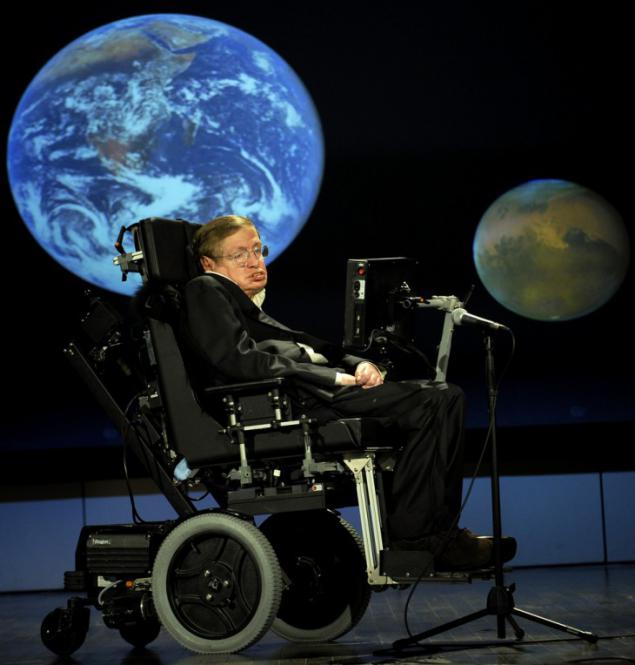
All of nichegone where did unimaginably small point - our universe - the moment of the Big Bang? The same way, and a cup of coffee: nothing. Just disappear and reappear protons in the coffee beverage, the universe came from nothing, and the big bang was caused by ... nothing!
However, the next moment after the event something amazing happened: time began. That is why go back in time to the Big Bang, it is impossible - it just does not exist. So, there was no cause of the universe, because in the presence of a causal link also takes time. God did not have time to establish the cause of the universe. For most of Stephen Hawking does all this mean the impossibility of creation and the creator himself, because this, too, there was no time.
In addition, the quantum theory of space-time can be finite in length (starting from the moment of the Big Bang), but does not have singularities that form a border or edge. The universe, therefore, "closed" on itself, it has no boundaries, it is completely isolated and does not interact with anything outside itself.
via naked-science.ru/article/nakedscience/stephen-hawking-science-and-religion

«For centuries it was thought that people like me, that is, people with disabilities, cursed by God. I think I'm somebody now! Destroy, but I personally believe that it is possible to explain everything in a different way - namely, the laws of nature "- a word the most famous scientist of our time, the British astrophysicist Stephen Hawking. They reveal the essence of the relationship with the Supreme Hawking.
No need to be a psychologist to understand Hawking lifetime struggling with God for the fact that he did so "punished." But perhaps it was the opposite - the creator of "punishing" the scientist, because, while still a young man, before his illness, he decided to grasp its secret? The irony of this paradox can only be compared with the irony of the universe, closed itself to itself, which is finite in extent, but it has no boundaries. Such antinomies exist at the boundary of physics and philosophy. But in terms of the laws of nature - is there a creator? We will tell you what he thinks about Stephen Hawking.
Science and religiyaEti opposites are fighting each other for about three thousand years. In 1277 Pope John XXI was so scared that there are laws of nature that announced their heresy. But, alas, he was not able to forbid even one of them - gravity. A few months later the roof collapsed palace directly on the pope's head.
However, the religion with its plastic logic immediately found a solution to all problems. She quickly announced laws of nature, the handiwork of God, which will change these laws at any time, as soon as the "want." And a fire - who conceive another.
Later it turned out that all a bit more complicated. The humble church was ready for it. In 1985, at a conference on cosmology in the Vatican, Pope John Paul II said that there is nothing reprehensible in the study of the universe. "But we - said the pope - no need to wonder about its origins, since it was the handiwork of the Creator." But Stephen Hawking is still wondered.
To answer this question, according to Hawking, you must understand the nature of all three ingredients that make up the "meal of the Universe": matter, energy and space. But where did they come to this "kitchen"? The answer is given by Einstein. But he "stood on the shoulders of giants", so first things first.

Aristotle, Newton and GalileyV basis of his laws of motion, Newton is known to put Galileo's measurements. Recall that in the last experiments with the body rolled down an inclined plane under the influence of a constant force, gave him constant acceleration. Thus, it was shown that the actual effect of the force - speed variation of the body, rather than bringing it in motion, as it was considered before. Another implied that the body is not exposed to any force, it moves in a straight line at a constant velocity (Newton's first law).
In addition to the laws of motion, Newton's work and describe the determination of the specific type of forces - gravity. According to the law of gravity, any two bodies attract each other with a force directly proportional to the product of their masses.
The main difference between the views of Aristotle on the one hand and the ideas of Galileo and Newton, the other is that Aristotle believed peace natural state of any body to which it is committed, if the action does not feel any force. Aristotle, for example, believed that the earth is in a state of rest. But Newton's laws should be: there is no rest. Everything is in motion. And the earth and the train riding on it.
What is this? The lack of an absolute "standard of rest" for physics was the same effects that pupils Parish School - university entrance. It followed that it is impossible to determine whether there will be two events occurring at different times in the same place. And it already means nothing, as the absence of an absolute, fixed space. Newton is strongly discouraged because it is not consistent with the idea of an absolute God. In the end, it actually refused the conclusion that it was a consequence of the discovery of the law.
But in Aristotle and Newton found a common "calming": the belief in the absolute time. They believed that it is possible to measure the interval between the two events, and the resulting figure is the same, no matter who measured (if you use the exact hours, of course). In contrast to the absolute space, absolute time very ladilo with Newton's laws, and the majority of people today believe that it is common sense. But then came Einstein ...

3 equal 2Nazyvavshy himself "a gypsy and a hobo," the great Einstein found that the two components of the universe - matter and energy - it is, in fact, the same as the two sides of the same coin. His famous E = mc2 (where E - energy, m - weight, c - velocity of light in vacuum) means that a lot can be considered as a form of energy, and vice versa. Thus, the universe should be considered as "pie" consisting had only two components: energy and space. But how did he come to this?
The same subject - for example, a flying ball ping-pong table - can be attributed to different speeds. It all depends on what kind of frame of reference with respect to the speed measured. If the ball is thrown inside the riding train - its speed can be calculated with respect to the train, and it is possible - with respect to the land on which the train rides, and which, as is known, is also moving in and around its axis and around the sun, which itself is moving ... and so on, without end.
If you believe Newton's laws, the same should apply to the light. But thanks to science, Maxwell became known that the speed of light is constant, no matter where we measured it either. In order to reconcile the theory of Maxwell with Newtonian mechanics was accepted hypothesis is that everywhere, even in a vacuum, there is a certain medium-called "ether." Ester According to the theory, light waves (as we know it has the properties of both the light and the wave, and the particles) is distributed in it as well as the sound waves in the air, and their speed must be measured relative to this ester. In this case, different observers have different values recorded speed of light, but relative to the ether, it would have remained constant.
However, the famous Michelson-Morley experiment, which took place in 1887, has forced scientists to abandon the idea of ether forever. To the great surprise of the experimenters, they were able to prove that the speed of light never changes, relative to what it would have not been measured.

The principle of relativity states that the laws of physics should be the same for all freely moving systems, regardless of their speed. This was true for Newton's laws of motion, but now Einstein extended his hypothesis and the theory of Maxwell.
This means that since the speed of light is constant, a freely moving observer should signal the same value that would not depend on the speed with which it is close to the light source or removed from it. This simple conclusion to explain the appearance of the speed of light in Maxwell's equations without the use of ether or any other privileged system of reference. But the same conclusion followed a number of other incredible discoveries. And, above all, a change in the idea of time.
For example, according to the special theory of relativity, a man riding on a train, and the one that stands on a platform that will disperse in the evaluation of the distance traveled by light from a single source. And since the rate - the distance divided by time, the only way for observers to come to a general conclusion about the speed of light - is to disperse well in time evaluation. That's the theory of relativity has done away with the idea of absolute time!
Another conclusion HUNDRED - is the inseparability of time and space, which constitute a kind of community, the space-time.
Developing the ideas of SRT in the general theory of relativity, Einstein showed that gravity - not some attractive force, and due to the fact that space-time is curved mass and energy that are in it.

In this regard, let us return to the destroyed before the foundation of the illusion of absolute time. Einstein proved that around massive bodies, such as, for example, the Earth must slow down and the passage of time (roughly speaking, this happens because of the curvature of space, and hence the time - some of their "stretch" around a massive body). The greater the weight, the slower its surroundings will flow time, and vice versa.
As is known, on the earth's orbit, time flows faster than the planet, so the astronauts back home a little younger than they would be if chose another profession, and always would be on Earth. However, this "youthfulness" of astronauts almost impossible to watch. Firstly, due to proximity to the Earth's orbit to the Earth, and secondly, because of the short stay of astronauts in orbit. But if anyone of them was able to go to space travel on the ship, reach speeds close to the speed of light, and come back in a year, he certainly would not have found in living not only one of their loved ones, but many generation of his grandchildren and great grandchildren.

Big vzryvVernemsya two other ingredients from which "cooked" the universe: energy and space. Where did they? Today, scientists say: they are the result of the Big Bang. But what is the Big Bang?
Approximately 13, 7 billion. Years ago the universe was compressed into one incredibly small point. This is evidenced not only the well-known red shift, but all the solutions of Einstein's equations. Sometime in the past, the distance between neighboring galaxies must have been zero. The universe had to be compressed to the point of zero size, the sphere of zero radius. The density of the universe and the curvature of space-time in the good times were to be endless. They ceased to be only in the Big Bang.
Another infinite value in the age of infancy of the universe had to be temperature. It is believed that at the time of the Big Bang the universe was infinitely hot. As soon as the universe expanded, the temperature was lowered and. Hence it originates what we call matter. The fact that at such high temperatures that were in the universe at the beginning of time, could not be formed, not only the atoms and subatomic particles. But with decreasing the energy they have to connect with each other. So there was a substance.
After about 100 seconds after the Big Bang, the universe cooled to a billion degrees (this is the temperature of the subsoil of the hottest stars). Under these conditions, the energy of protons and neutrons is no longer sufficient to overcome the strong nuclear force. They begin to merge, forming the nucleus of deuterium (heavy hydrogen), consisting of a proton and a neutron. And then deuterium nuclei, protons and neutrons allying could turn into a helium nucleus. The remaining elements are born later in the course of thermonuclear fusion inside the hydrogen-helium stars.
After all this is truly "hot" ado about a million years, the universe just continued to grow, and nothing significant happened. But when the temperature dropped to a few thousand degrees, the kinetic energy of the electrons and nuclei was not enough to overcome the force of electromagnetic attraction, and they began to unite into atoms. This is how the matter in the usual sense of the word.
What about anti-matter? What is it and where did it? According to the laws of physics, there is negative energy. In order to understand what it is, we give an analogy. Imagine that someone wants to build a big hill on the flat terrain. Hill - is our universe. To create a hill that someone digs a big hole. Pit - this is the "negative version of" hill. What was in the pit, it is now a hill, so the balance is fully preserved. The same principle was the basis of "erection" and our universe. As a result of the Big Bang was created by a large number of positive energy - at the same time formed the same amount of negative energy. But where is she? A: everywhere in the space. "The Pit" - is our space and all matter to which we are accustomed, and which can be observed, that is, what is in the universe - a "hill».

Quantum mehanikaV the Big Bang the universe was compressed into an unimaginably small point. And it is at this subatomic level crashes general theory of relativity, as in his time Newton's laws have failed when they tried to apply in respect of movement of light.
At the subatomic level are quite different, really fantastic laws, which have no analogues in our everyday life. Therefore, the science that studies the laws dealing with the phenomena that occur in a very small scale - quantum mechanics - is so difficult to understand. Universe in the Big Bang - a place where the laws of quantum mechanics.
But, wanting to add up all the puzzles of the universe, Stephen Hawking holds the greatest hope for their creation of a unified theory of the functioning of the universe - a theory of quantum gravity. It has to reconcile general relativity with quantum mechanics.
God plays kostiKvantovaya mechanics is based on the so-called principle of uncertainty. It says a particle does not have a separate well-defined positions and velocities. But they have so-called quantum states, a combination of characteristics that are known only within the limits allowed by the uncertainty principle.
Quantum mechanics at one point crossed all hopes that the universe and all the processes it can be predicted. She has made a science worst - an accident. The laws of quantum mechanics offer a variety of possible outcomes of something and say how likely each of them. That is why Einstein to the end of his life and did not accept quantum mechanics. His attitude towards it, he expressed his famous phrase, 'God does not play dice ».
One of the most important consequence of the uncertainty principle - is that in some respects the particles behave like waves. They do not have a definite position, but the "smeared out" over the space, according to the probability distribution. And yet, according to the laws of quantum mechanics, a particle is not any particular "history", that is, the path of movement in space-time. Instead, the particle moves within a certain range of all possible trajectories, that is, is, paradoxically, in several places at once.
This can be understood only by the brain, calculations and equations, feelings and logic make it virtually impossible. In our everyday life, a cup of coffee in the morning does not appear just like that. To our table originated drink need to take the coffee beans, sugar, water and milk. But if you look deeper into a cup of coffee, at the subatomic level, you can witness this witchcraft. And all because at this level the particles are functioning according to the laws of quantum mechanics. They suddenly appear there for a while, just as suddenly vanish - and reappear.

All of nichegone where did unimaginably small point - our universe - the moment of the Big Bang? The same way, and a cup of coffee: nothing. Just disappear and reappear protons in the coffee beverage, the universe came from nothing, and the big bang was caused by ... nothing!
However, the next moment after the event something amazing happened: time began. That is why go back in time to the Big Bang, it is impossible - it just does not exist. So, there was no cause of the universe, because in the presence of a causal link also takes time. God did not have time to establish the cause of the universe. For most of Stephen Hawking does all this mean the impossibility of creation and the creator himself, because this, too, there was no time.
In addition, the quantum theory of space-time can be finite in length (starting from the moment of the Big Bang), but does not have singularities that form a border or edge. The universe, therefore, "closed" on itself, it has no boundaries, it is completely isolated and does not interact with anything outside itself.
via naked-science.ru/article/nakedscience/stephen-hawking-science-and-religion
10 quick facts about the human body, that science still can not explain about
12 scientifically proven facts about how useful to be a bitch

